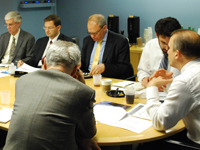Registration
You will receive an email confirming your registration.
IMGXYZ2753IMGZYXRussia’s economy suffered one of the world’s steepest declines in gross domestic product (GDP) in the wake of the global financial crisis. Two years later, Russia’s economic indicators still tell a grim story. Carnegie’s Sergei Aleksashenko and Pekka Sutela discussed the current state of Russian economy and its prospects for recovery. Carnegie’s Matthew Rojansky moderated.
The Current Economic Climate
Russia began its economic recovery in the third quarter of 2009. While other countries exhibited a slow but steady growth after the recession, Russia’s path toward recovery has been considerably more difficult. Despite optimistic statements by Russian authorities, Russia’s growth rate of only 4 percent has led to stagnation in several sectors of the economy.
- Export: Russia’s economic recovery was primarily export-driven in the second half of 2009, stated Aleksashenko. Resumed growth in Russian exports correlated with a recovery of global trade. Yet even though exports grew, they only reached, but did not exceed, the pre-crisis level. While in normal economic conditions a small increase in exports might have triggered economic growth, in the current post-recession economy exports alone are insufficient to support Russia’s recovery, explained Aleksashenko.
- Industry: Industry, a critical component of the Russian economy, is performing below its pre-crisis level as well, stated Aleksashenko. The only growth of note has been in those industries that benefited directly from the boost in foreign trade.
- Household Income: Unemployment remains high, with the official numbers skewed because they fail to include many unregistered foreign workers, who dominate the construction and retail industries. Yet despite high unemployment rates, Aleksashenko explained that household income has grown in the past two years due to increased government spending on wages and pensions. This growth in income contributed to an increased flow of imports into Russia, affecting Russia’s trade balance, explained Aleksashenko.
Potential Economic Catalysts
Aleksashenko outlined some of the tools used by the Kremlin to stimulate economic growth in the past:
- Ruble devaluation (1999-2003): In the wake of the 1998 economic crisis, Moscow devalued the ruble in order to increase consumer demand and boost domestic manufacturing. This enabled Russian companies to produce goods that were currently being imported by domestic consumers and increase their exports.
- Privatization (2000-2005): Privatization was a key element in helping to revive Russia’s struggling economy in the first half of the decade. This increase in the private sector was matched by an interest among private companies in increasing efficiency, which led to the recovery of a number of domestic companies and stimulated an increase in production.
- Foreign Investment (2005-2008): An inflow of foreign investment sparked an increase in domestic demand and created significant growth. The funds generated by foreign loans revitalized several sectors of the economy.
However, Aleksashenko cautioned, most of these recovery tools that helped instigate growth in the past decade are not available today. Only foreign investment remains as a potential remedy for Russia’s staggering economy.
Concerns
Aleksashenko listed a number of potential problems that, left unaddressed, could further impede Russia’s economic recovery:
- Social conditions: Russia suffers from a number of social problems that diminish the possibility of a significant increase in foreign investment, including inconsistent compliance with the rule of law, endemic corruption, blatant disregard for property rights, and a lack of transparency and corporate ethics.
- Competitiveness: Poor quality of goods and services and a lack of competitiveness in the private sector further impede the recovery of the Russian economy.
- Weak institutions: Russia’s experience during the crisis demonstrated that, while there is no proven correlation between strong institutions and strong economic growth, weak institutions contribute to a rapid economic decline and impede long-term growth.
- Current account: As a result of the crisis, Russia’s current account balance has dropped significantly and may even become negative in 2011. Strongly dependent on the oil industry, the Russian economy can preserve its already weak current account only if oil prices remain stable.
- Budget: The Kremlin has focused its spending on expanding social benefits and the defense sector. Such expenditures do not result in sustainable long-term economic growth and are perceived by analysts as a political move to sate a disgruntled population, stated Aleksashenko. The recent pension increase and budget reduction have created a significant fiscal burden, and are driving down public demand, especially in the investment sector.
- Defense: Military expenditures are expected to grow by 70 percent by 2013. According to a statement by the Russian Ministry of Defense, military expenditures will account for 29.4 percent of federal budget expenditures and 4.7 percent of GDP by 2020, compared to 12.4 and 2.9 percent in 2010, respectively.This increase in military spending detracts from resources available to other sectors and does not stimulate sustainable long-term growth.
Conclusions
- Weak Foundation: The global financial crisis was a severe blow to the Russian economy, revealing its weakened and flawed economic apparatus, stated Aleksashenko.
- Exhausted Economic Drivers: The initial recovery in the second half of 2009 was based on exports, whose potential is currently exhausted. Recovery is unlikely to come from other sources, such as foreign investment, unless Russia pays greater attention to the rule of law and cracks down on corruption, argued Sutela.
- Bleak Future: Both experts agreed that even with 4 percent annual growth, Russia’s economy will perform well below its pre-crisis production level. Declining human capital, crumbling infrastructure, and rapidly depleting natural resources will all contribute to Russia’s slow recovery, Sutela concluded.
